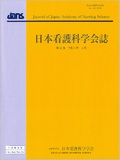Japanese
English
- 販売していません
- Abstract 文献概要
- 参考文献 Reference
要旨
目的:本研究は熊本地震後の看護職のうつ/PTSR悪化予防介入プログラムを評価した.
方法:介入群230名と質問紙調査の対照群270名を対象とした.介入群に2時間のセルフケア強化に関する心理教育と3時間の力動的集団精神療法,合計5時間を実施し,介入前後,介入1・3・6か月後に評価を行った.評価はうつ,PTSD陽性率,災害後反応,SF-8で行った.
結果:熊本地震1年7か月後の介入群のうつ,PTSD陽性率は高かった.しかしうつ/PTSR悪化予防介入プログラムでうつ,PTSD陽性率,震災後反応に変化がみられた.
考察:今回介入群のうつとPTSD陽性率は対照群と比較すると高かったが,プログラムの実施で,介入3か月後にうつは最も下がり,PTSD陽性率も6か月後に下がっていた.しかしうつは依然として強く,介入群はストレスを受けて震災後の生活を送っていた.
結論:被災後,被災者兼支援者のうつ/PTSR悪化予防を行うことでPTSD陽性率は軽減し,震災反応が変化した.
Purpose: The purpose of this study was to evaluate an intervention program designed to prevent the worsening of depression and Post-Traumatic Stress Response (PTSR) among nurses who were victims of the Kumamoto Earthquake themselves and provided care to others.
Method: This study carried out a quasi-experiment among two groups: an intervention group (n = 230) who participated in a preventive intervention program for depression and PTSR, and a control group (n = 270) to whom questionnaires were administered. The preventive intervention program comprised a two-hour psychoeducation session on self-care and a three-hour dynamic group psychotherapy session intended to promote self-care, totaling five hours. Evaluation was conducted before and after the intervention, one month later, three months later, and six months later. The evaluation indicators were depression scores, PTSD positive rates, DCTR (Dynamic Change for Trauma Response), and SF-8 (Health-related Quality of Life).
Results: One year and seven months after the Kumamoto Earthquake, depression scores and PTSD positive rates were high in the intervention group. However, after the intervention program, improvement was observed in the depression scores, PTSD positive rates and DCTR scores.
Discussion: The implementation of the preventive intervention program, depression levels and the PTSD positive rates also decreased. However, depression was still persistent, suggesting that the intervention group was leading a life under stress after the earthquake.
Conclusion: Preventive intervention program brings change PTSD positive rate and DCTR, even if it had passed one year and seven months after disaster.
Copyright © 2021, Japan Academy of Nursing Science. All rights reserved.


